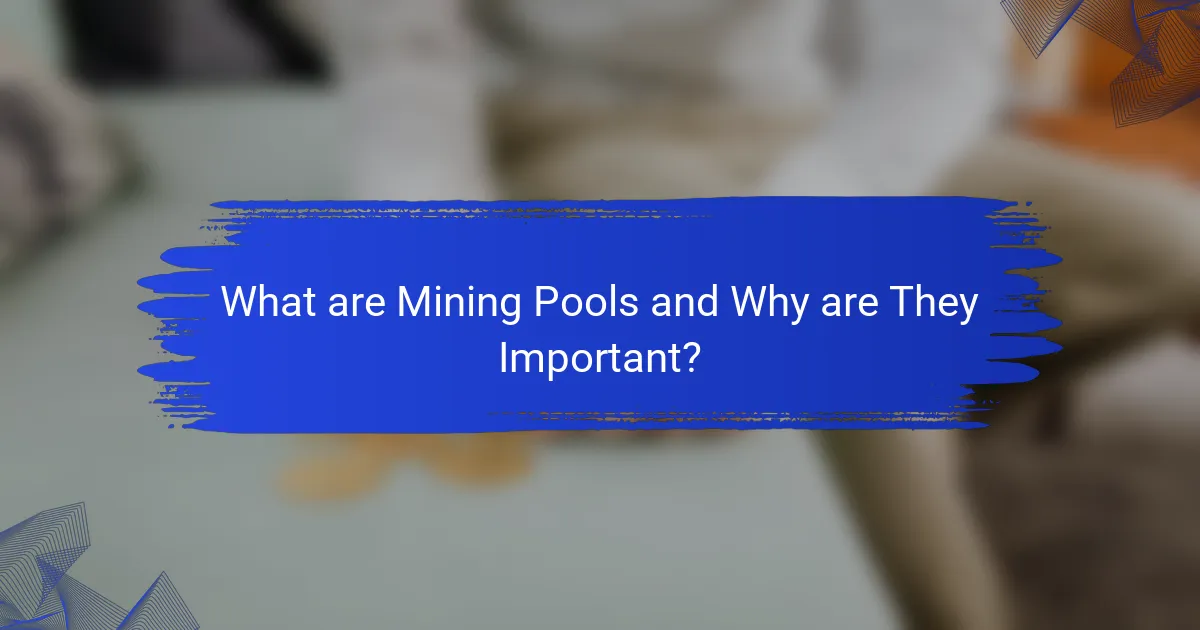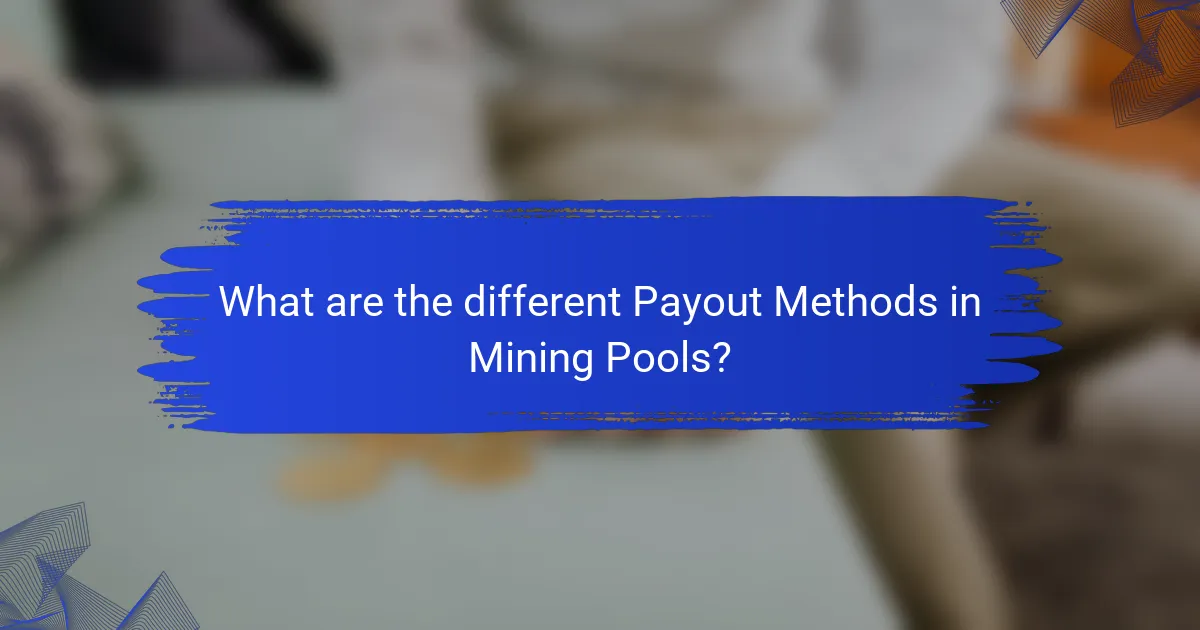Mining pools are collaborative groups of cryptocurrency miners who combine their computational resources to enhance their chances of successfully mining blocks and receiving rewards. This article explores the significance of mining pools in providing stable income for individual miners, who often face unpredictable earnings. It details the fee structures associated with mining pools, typically ranging from 1% to 3%, and outlines various payout methods, including Pay-Per-Share (PPS), Pay-Per-Last-N-Shares (PPLNS), and Shared Maximum Pay-Per-Share (SMPPS). Understanding these elements is crucial for miners looking to optimize their earnings and navigate the complexities of the cryptocurrency mining landscape.

What are Mining Pools and Why are They Important?
Mining pools are groups of cryptocurrency miners who combine their computational resources to increase the chances of successfully mining blocks. They share the rewards based on the amount of work contributed by each participant. Mining pools are important because they provide a more stable and predictable income for miners. Individual miners often face long periods without rewards due to the difficulty of mining. By pooling resources, miners can receive smaller, more frequent payouts. This collaboration enhances mining efficiency and reduces the variance in earnings. According to a report by CoinDesk, mining pools account for over 70% of the total Bitcoin hash rate, demonstrating their significance in the mining ecosystem.
How do Mining Pools function in the cryptocurrency ecosystem?
Mining pools function by allowing multiple cryptocurrency miners to combine their computational resources. This collaboration increases the probability of successfully mining a block. When a block is mined, the reward is distributed among the participants based on their contributed processing power. This method reduces the variance of payouts for individual miners. Miners join pools to receive more consistent rewards compared to solo mining. The pool operator manages the technical aspects and distributes the rewards. According to a report by CoinDesk, over 60% of Bitcoin mining occurs in pools, highlighting their significance in the ecosystem.
What roles do miners play within a mining pool?
Miners in a mining pool perform several key roles. They contribute their computational power to solve complex mathematical problems. This collective effort increases the chances of successfully mining new blocks. Miners also share the rewards based on their contributed power. Each miner’s contribution is tracked by the pool’s software. The pool distributes payouts according to predefined algorithms. Miners can choose to join different pools based on fees and payout structures. This collaboration enhances overall mining efficiency and profitability.
How is the collective power of a mining pool utilized?
The collective power of a mining pool is utilized to increase the chances of successfully mining blocks. By combining computational resources, miners can solve cryptographic puzzles more efficiently. This collaboration leads to a higher probability of earning rewards compared to solo mining. Mining pools distribute rewards based on each member’s contributed power. This method ensures more consistent payouts for participants. The pooled resources allow for a more steady income stream. Overall, mining pools enhance the efficiency and profitability of the mining process.
What are the advantages of joining a Mining Pool?
Joining a mining pool increases the chances of earning rewards consistently. Mining pools combine the computational power of multiple miners. This collective effort leads to a higher probability of successfully mining blocks. Individual miners often face long wait times for rewards. In a pool, rewards are distributed more frequently. This distribution is based on each miner’s contributed power. Additionally, mining pools often provide lower variance in earnings. Miners can also benefit from shared resources and knowledge. This collaboration enhances overall mining efficiency and profitability.
How do Mining Pools increase the chances of earning rewards?
Mining pools increase the chances of earning rewards by combining the computational power of multiple miners. This collective effort enhances the likelihood of solving cryptographic puzzles. A higher combined hash rate means more frequent block discoveries. Consequently, miners in the pool receive a share of the rewards proportional to their contributed power. For instance, a pool with a hash rate of 10 TH/s is more competitive than a solo miner with 1 TH/s. Statistically, pools can reduce the variance in reward distribution. This leads to more consistent payouts for individual miners. Overall, mining pools enable participants to earn rewards more reliably than solo mining.
What collaborative benefits do miners gain from Mining Pools?
Miners gain several collaborative benefits from Mining Pools. First, they increase their chances of earning rewards. By pooling resources, miners can collectively solve blocks more frequently than they could individually. This leads to more consistent payouts. Additionally, Mining Pools reduce variance in earnings. Individual miners face fluctuations based on luck, while pools provide steady income through shared rewards.
Moreover, miners benefit from shared computational power. This collective strength allows for greater efficiency in solving complex algorithms. Lastly, Mining Pools foster community and knowledge sharing among miners. Members can exchange tips and strategies to improve performance. These collaborative benefits make Mining Pools an attractive option for miners seeking stability and support.

What are the Fee Structures associated with Mining Pools?
Mining pools typically have fee structures that range from 1% to 3% of the rewards earned. These fees are deducted from the block rewards before distribution to miners. The fee percentage can vary based on the pool’s policies and the services it offers. Some pools may charge a flat fee per share submitted. Others might implement a tiered fee structure based on the amount of cryptocurrency mined. Additionally, certain pools may offer lower fees as incentives for larger contributors. These fee structures are designed to cover operational costs and provide profit to the pool operators.
How are fees structured in different Mining Pools?
Mining pools typically structure fees as a percentage of the rewards earned. Most mining pools charge between 1% to 3% of the total payout. This fee supports the pool’s operations and infrastructure. Some pools use a tiered fee structure. In this model, lower fees apply to higher contribution levels. Other pools may have a flat fee regardless of contribution. Additionally, some pools offer no fees for a limited time to attract miners. It’s essential to review each pool’s fee structure before joining. This ensures miners understand the costs associated with their participation.
What are common fee models used by Mining Pools?
Common fee models used by mining pools include proportional, pay-per-share (PPS), and pay-per-last-N-shares (PPLNS). In the proportional model, miners receive rewards in proportion to the number of shares they contribute. This model distributes payouts based on the total shares submitted during a round. Pay-per-share guarantees miners a fixed payment for each share submitted, regardless of the pool’s success. This model reduces risk for miners but may have higher fees. Pay-per-last-N-shares rewards miners based on the last N shares submitted, which can incentivize consistent participation. Each model has its advantages and disadvantages, affecting miners’ earnings and risk levels.
How do fees impact miners’ overall profitability?
Fees directly reduce miners’ overall profitability. Miners incur fees for transactions processed within a block. Higher fees can improve profitability by incentivizing miners to prioritize certain transactions. Conversely, excessive fees may deter users from transacting, leading to reduced network activity. This can result in fewer transactions for miners to process. In mining pools, fee structures vary, impacting individual miner earnings. Pools with lower fees can enhance profitability for participants. Overall, fees play a crucial role in determining the net earnings of miners.
What factors should miners consider when evaluating fee structures?
Miners should consider transaction fees, pool fees, and payout structures when evaluating fee structures. Transaction fees impact overall profitability, as they are deducted from rewards. Pool fees vary by mining pool and can significantly affect net earnings. Payout structures determine how and when miners receive their earnings. Miners should also evaluate the minimum payout thresholds. Additionally, miners need to assess the stability and reliability of the mining pool. A transparent fee structure is crucial for informed decision-making. Understanding these factors helps miners optimize their returns.
How do varying fee percentages affect potential earnings?
Varying fee percentages directly impact potential earnings in mining pools. Higher fee percentages reduce the total payout to miners. For example, a 1% fee on earnings of $100 results in a payout of $99. Conversely, a 5% fee on the same earnings yields a payout of $95. This difference illustrates how fees can diminish overall profits. Miners must consider fee structures when choosing a pool. Lower fees generally lead to higher net earnings. Research shows that even small fee differences can significantly affect long-term profitability. Thus, miners should evaluate fees carefully to maximize earnings.
What hidden costs might miners encounter in Mining Pools?
Miners in mining pools may encounter hidden costs such as pool fees and transaction fees. Pool fees typically range from 1% to 3% of the rewards earned. These fees can significantly reduce overall earnings over time. Transaction fees may also apply when miners submit their mined blocks to the blockchain. Additionally, miners may face costs related to network congestion, which can increase transaction fees during peak times. Some pools may have withdrawal fees that miners must pay to access their earnings. Miners should also consider the potential costs of hardware and electricity that may not be fully accounted for in pool agreements. Understanding these hidden costs is essential for accurate profit calculations.

What are the different Payout Methods in Mining Pools?
The different payout methods in mining pools include Pay-Per-Share (PPS), Pay-Per-Last-N-Shares (PPLNS), and Shared Maximum Pay-Per-Share (SMPPS). PPS guarantees a fixed payout for each share submitted, regardless of whether a block is found. PPLNS pays miners based on the number of shares they contributed in the last N shares submitted before a block is found. SMPPS combines elements of both PPS and PPLNS, offering a fixed payment per share while also considering the pool’s overall performance. These methods help distribute rewards among miners based on their contributions and the pool’s success in mining blocks.
How do various payout methods work in Mining Pools?
Mining pools utilize several payout methods to distribute earnings among participants. Common payout methods include Pay-Per-Share (PPS), Pay-Per-Last-N-Shares (PPLNS), and proportional payouts.
PPS guarantees a fixed payout for each share submitted, providing immediate rewards. This method is beneficial for miners seeking consistent income. PPLNS calculates payouts based on the number of shares submitted over a specific period. It rewards miners based on their contribution to the pool’s success. Proportional payouts distribute earnings based on the number of shares submitted relative to the total shares mined.
Each method has its advantages and can affect miners’ profitability. For example, PPS may have higher fees due to guaranteed payouts. In contrast, PPLNS may lead to higher rewards during profitable mining periods. Miners should choose a method that aligns with their risk tolerance and income needs.
What are the most common payout methods used by Mining Pools?
The most common payout methods used by mining pools are Pay-Per-Share (PPS), Pay-Per-Last-N-Shares (PPLNS), and proportional payout systems. PPS pays miners a fixed amount for each share submitted, regardless of block discovery. PPLNS rewards miners based on the number of shares they contributed during the last N shares before a block is found. Proportional systems distribute payouts based on the number of shares submitted relative to the total shares in a round. These methods ensure fair compensation for miners’ contributions to the mining process.
How does each payout method affect miners’ earnings?
Different payout methods significantly impact miners’ earnings. Each method has unique characteristics that affect the timing and amount of payments.
Pay-per-share (PPS) guarantees miners a fixed payout for each share submitted, providing stable earnings. This method reduces the variance in payouts, making income predictable.
Pay-per-last-N-shares (PPLNS) rewards miners based on the number of shares submitted in relation to the last N shares. This method can lead to higher earnings during lucky streaks but may result in lower payouts during unlucky periods.
Proportional payout methods distribute earnings based on the proportion of shares submitted relative to the total shares of the pool. This method aligns earnings closely with contributions but may introduce variability in payouts.
Finally, the shared maximum payout (SMP) method caps payouts to manage pool finances. While it protects the pool’s sustainability, it can limit individual miner earnings during high-reward periods.
Overall, the choice of payout method influences the stability, predictability, and potential variability of miners’ earnings.
What should miners know about payout thresholds and timing?
Miners should know that payout thresholds determine the minimum amount of cryptocurrency needed to trigger a payout. Each mining pool sets its own payout threshold, which can vary significantly. For example, some pools may require a threshold of 0.01 BTC, while others may set it at 0.001 BTC. Timing of payouts can also differ between pools. Some pools offer immediate payouts after reaching the threshold, while others may have scheduled payouts, such as daily or weekly. Understanding these factors helps miners manage their earnings effectively. Miners should also be aware that higher thresholds may lead to longer wait times for payouts. This is crucial for cash flow management in mining operations.
How do payout thresholds vary among Mining Pools?
Payout thresholds among mining pools vary significantly based on the pool’s policies. Some pools set low thresholds, allowing miners to withdraw earnings quickly, often around 0.001 BTC. Other pools may have higher thresholds, sometimes exceeding 0.01 BTC, requiring miners to accumulate more before withdrawal. Additionally, certain pools implement a variable threshold based on the miner’s contribution level. For example, larger contributors may benefit from lower payout thresholds. This variability is influenced by the pool’s fee structure and operational costs. Miners should review each pool’s specific payout policies to understand these differences.
What are the implications of payout timing for miners?
Payout timing significantly impacts miners’ cash flow and profitability. Timely payouts allow miners to reinvest earnings quickly. This can enhance their mining operations and upgrade equipment. Delayed payouts may lead to liquidity issues for miners. Miners may struggle to cover operational costs without prompt payments. Additionally, payout timing influences miners’ decisions on joining specific mining pools. Pools with frequent payouts attract more miners seeking immediate returns. In contrast, pools with longer payout intervals may deter participation. Thus, payout timing affects both individual miners and the overall dynamics of mining pools.
What best practices can miners follow when choosing a Mining Pool?
Miners should evaluate mining pools based on reputation, fees, and payout methods. A reputable pool has a history of reliable payouts and strong community feedback. Miners should compare the fee structures of different pools. Fees can significantly impact overall earnings. Payout methods should align with miners’ preferences, such as Pay-Per-Share or Pay-Per-Last-N-Shares. Miners should also consider the pool’s hash rate and size. Larger pools may offer more consistent payouts but can have higher competition. Additionally, checking the pool’s uptime and server locations is vital. A stable connection and low latency enhance mining efficiency. Lastly, miners should assess the pool’s transparency regarding operations and governance. Transparent pools build trust and provide clear information on earnings.
Mining pools are collaborative groups of cryptocurrency miners who combine their computational resources to enhance the chances of successfully mining blocks and receiving rewards. This article outlines the significance of mining pools in providing stable income, the roles miners play within these pools, and the advantages of joining one. It further examines the various fee structures, payout methods, and factors that influence miners’ overall profitability. Additionally, it highlights best practices for miners to consider when selecting a mining pool, ensuring informed decision-making for optimal earnings.